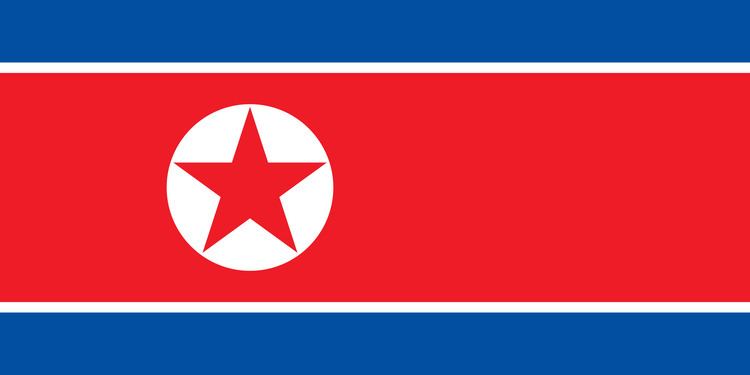Designed by Unknown Adopted on 8 September 1948 Country North Korea | Use National flag, Ensign Proportion 1:2 | |
 | ||
Name Ramhongsaek Gonghwagukgi Design A wide red stripe at the center, bordered by a narrow white stripe both above and below, followed by a blue stripe. The central red stripe carries a five-pointed red star within a white circle near the hoist. | ||
The flag of North Korea, also known as the Ramhongsaek Gonghwagukgi is the ensign and national flag of North Korea. It was adopted on 8 September 1948 and is defined in Article 170 of Chapter VII of the North Korean constitution.
Contents
Design
According to article 170 of Chapter VII of the Socialist Constitution of the Democratic People's Republic of Korea (North Korea):
The national flag of the Democratic People's Republic of Korea consists of a central red panel, bordered both above and below by a narrow white stripe and a broad blue stripe. The central red panel bears a five-pointed red star within a white circle near the hoist.
The ratio of the width to the length is 1:2.
Symbolism
The North Korean flag's prominent red star is a universal symbol of communism, although since the flag's adoption, the application of the Marxist-Leninist-natured philosophy of Juche has replaced communist authority as the state's guiding ideology, and references to communism have been systematically removed from the country's constitution and legal documents.
The red stripe expresses revolutionary traditions. The two blue stripes stand for sovereignty, peace and friendship. The white stripes symbolize purity.
The website of the Korean Friendship Association indicates, on the contrary, the red star represents revolutionary traditions, the red panel is indicative of the patriotism and determination of the Korean people. The white stripes symbolizes ethnic purity of the unified nation and its culture. The blue stripes represent unity.
According to a typical North Korean official text published in Rodong Sinmun, Kim Il-sung gave the following significance to the elements of the flag:
The red colour of the flag symbolises the anti-Japanese fervour, the red blood shed by the Korean patriots and the invincible might of our people firmly united to support the Republic. The white colour symbolises the one bloodline, one land, one language, one culture of our monoethnic country, which lived in purity. And blue stands for the gallant visage of our people, symbolising the spirit of the Korean people fighting for world peace and progress.
The colors of the North Korean flag – red, white and blue – are considered national colors and symbolize respectively: revolutionary traditions; purity, strength, and dignity; and sovereignty, peace, and friendship.
History
When the northern portion of Korea became a socialist republic supported by the Soviet Union following the restoration of independence of Korea in 1945, the Taegukgi was once again in use.
Vice Chairman of the Provisional People's Committee for North Korea Kim Tu-bong was in favor of keeping the Taegukgi, but in 1947 the Soviets communicated via Major General Nikolai Georgiyevich Lebedev their wish to have the flag changed. The old flag with its traditional Korean elements, he noted, "sounds like a legend to me". Kim yielded and a few months later the design for the new flag was dictated from Moscow, although it is not known who the Soviet official was that designed the flag. Before its formal adoption, the Taegukgi remained in official use.
The design of the flag was disclosed, along with a draft constitution, on 1 May 1948. In July 1948 the new flag was approved by the provisional North Korean People's Assembly. The following month Kim, who formerly supported the traditional design, wrote a reasoned text On the Establishing of the New National Flag and the Abolition of Taegukgi. Thereby he explained the decision to adopt a new flag against the wishes of those who favored the old one In terms of North Korean official texts, Kim's account is unequivocally frank in acknowledging dissenting public opinion. In 1967, Kim Tu-bong was purged by Kim Il-sung who by that time had erected a cult of personality. Any mention of the use of Taegukgi was removed from texts and it was doctored out of photographs on the orders of Kim Il-sung who sought to monopolize North Korean history to serve him. Contemporary official North Korean accounts present the new flag of North Korea as personally designed by Kim Il-sung.
A 270-kilogram (600 lb) North Korean national flag flies from the world's fourth tallest flagpole, which is located at Kijŏng-dong, on the North Korean side of the Military Demarcation Line within the Korean Demilitarized Zone. The flag-pole is 160 meters (520 feet) tall.
Other flags
There are several other known flags in use. There are flags for the Korean People's Army (KPA), and its two subdivisions the Korean People's Air Force and Korean People's Navy, which follow a common design but with different colors (blue and white for the Navy and dark blue and light blue for the Air Force). There is also a flag of the ruling Worker's Party of Korea, modeled after similar communist party flags, and a flag for the Supreme Commander of the KPA used by Kim Jong-un, which has the Supreme Commander's Arms on a red field. KPA Guards units use the same common design but with the national arms at the center of the obverse.
